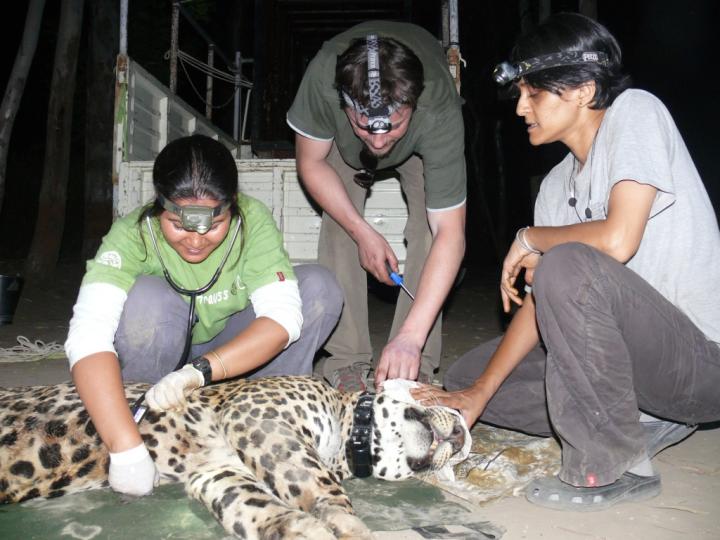Next-door leopards: First GPS-collar study reveals how leopards live with people

The research team attaches a GPS collar to a leopard. Credit: www.projectwaghoba.in
- Study says leopards stay surprisingly close to homes
- Leopard home range around humans can be comparable to world's best protected areas
Article available from PLOS ONE
In the first-ever GPS-based study of leopards in India, led by WCS and partners has delved into the secret lives of these big cats, and recorded their strategies to thrive in human-dominated areas.
The study concludes that leopards in human areas are not always 'stray' or 'conflict' animals but residents, potentially requiring policy makers to rethink India's leopard-management strategies.
The study was a collaboration of Vidya Athreya of WCS India (Wildlife Conservation Society), scientists from Norway (Morten Odden from Hedmark University College and John Linnell from Norwegian Institute for Nature Research), Sandeep Rattan of the Himachal Pradesh Forest Department, Maharashtra Forest Department and Asian Nature Conservation Foundation. Their findings were published recently in the journal PLOS ONE in the article “Adaptable Neighbours: Movement patterns of GPS-collared leopards in human-dominated landscapes in India.”
Five leopards (two males and three females) perceived as “problem animals” and captured from human-dominated areas despite no predatory attack on people, were radio-collared for the study. Two were translocated and released more than 50 km (31 miles) away, while the remaining three were released near the site of capture.
The scientists monitored the animals' activities from the time of release, for up to a year, recording their behavior – including strategies they adopt to avoid direct contact with people.
The findings Immediately after release, the two translocated animals moved away 89 km (55 miles) and 45 km respectively (28 miles) from the release sites.
Said co-author Vidya Athreya of WCS India: “This indicated futility of translocation as a management strategy; this could have in fact, aggravated the conflict, as these animals passed through highly-human dominated (even industrial) areas,” contended the scientists.
However, the animals applied tactics to avoid encountering people, despite dependence on their resources.
Firstly, the animals mostly moved at night, which timed perfectly with low human activity. They also spent more time closer to homes (<25 m [82 feet] in many location recordings) at night, than during the day.
“This gave them an access to people's livestock, and yet kept them safe from people,” Athreya explained.
That these leopards were residents in these human-dominated areas was also confirmed by the study.
The two translocated animals occupied bigger home ranges (42 km [26 miles]and 65 km [40 miles] respectively), including one in the outskirts of Mumbai. The other three lived in areas with highest human densities, but occupied smallest home ranges (8-15 sq km) (3-5.7 square miles) ever recorded for leopards anywhere.
“The home ranges of the three animals are comparable to those in highly-productive protected areas with a very good prey density,” said Athreya. “This indicated that food sources associated with humans [domestic animals] supported these leopards.”
Moreover, two of the females even gave birth to cubs during the course of the study, confirming their residence.
Despite living in close proximity to humans and even being dependent on their resources, none of the leopards were involved in human deaths during capture or following release.
The authors stress that the presence of wild carnivores like leopards in human use landscapes in India need to be dealt with proactive mitigation measures.
The authors say there is a need for more studies on ecology of wildlife that share space with humans in India, so that better understanding can feed into better policy. Efforts should be put into preventing losses to people rather than react after losses have been incurred. The management policy should also work towards retaining the acceptance and tolerance of the local people.
Wildlife Conservation Society (WCS)
MISSION: WCS saves wildlife and wild places worldwide through science, conservation action, education, and inspiring people to value nature. VISION: WCS envisions a world where wildlife thrives in healthy lands and seas, valued by societies that embrace and benefit from the diversity and integrity of life on earth. To achieve our mission, WCS, based at the Bronx Zoo, harnesses the power of its Global Conservation Program in more than 60 nations and in all the world's oceans and its five wildlife parks in New York City, visited by 4 million people annually. WCS combines its expertise in the field, zoos, and aquarium to achieve its conservation mission. Visit: http://www.wcs.org ; http://www.facebook.com /TheWCS; http://www.youtube.com/user/WCSMedia Follow: @thewcs.
CONTACT: STEPHEN SAUTNER: (1-718-220-3682; ssautner@wcs.org
JOHN DELANEY: (1-718-220-3275; jdelaney@wcs.org)
Media Contact
All latest news from the category: Ecology, The Environment and Conservation
This complex theme deals primarily with interactions between organisms and the environmental factors that impact them, but to a greater extent between individual inanimate environmental factors.
innovations-report offers informative reports and articles on topics such as climate protection, landscape conservation, ecological systems, wildlife and nature parks and ecosystem efficiency and balance.
Newest articles

NASA: Mystery of life’s handedness deepens
The mystery of why life uses molecules with specific orientations has deepened with a NASA-funded discovery that RNA — a key molecule thought to have potentially held the instructions for…

What are the effects of historic lithium mining on water quality?
Study reveals low levels of common contaminants but high levels of other elements in waters associated with an abandoned lithium mine. Lithium ore and mining waste from a historic lithium…

Quantum-inspired design boosts efficiency of heat-to-electricity conversion
Rice engineers take unconventional route to improving thermophotovoltaic systems. Researchers at Rice University have found a new way to improve a key element of thermophotovoltaic (TPV) systems, which convert heat…



